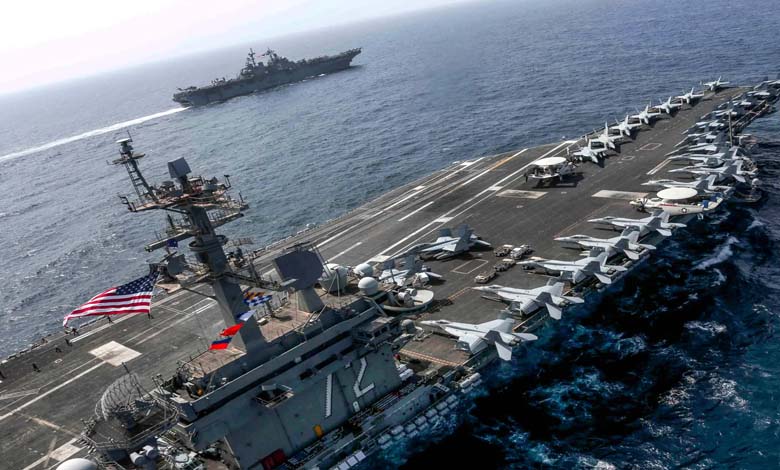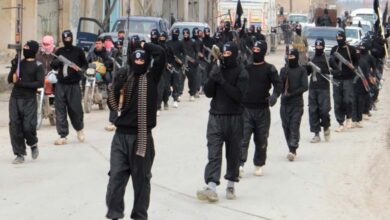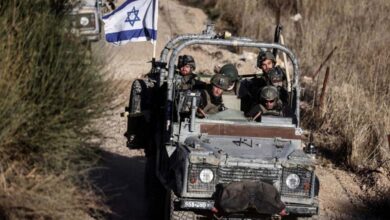Washington Plans to Deploy Fighters and Destroyers in the Region to Defend Israel

B-52 Stratofortress bombers, a squadron of fighters, refueling aircraft, and naval destroyers are set to arrive in the region in the coming months as a warning to Iran.
The United States announced the deployment of new military capabilities in the Middle East, expected to arrive “in the coming months” in a move “to defend Israel” and to warn Iran, according to a statement issued by the Pentagon on Friday.
-
Washington warns of a possible cut in relations between Israeli and Palestinian banks
-
Washington Seeks Normalization Between Israel and Saudi Arabia Before Presidential Elections
Major General Pat Ryder, a Pentagon spokesperson, stated in a release that Secretary of Defense Lloyd Austin has ordered the deployment of several B-52 Stratofortress bombers, a squadron of fighters, refueling aircraft, and naval destroyers to the Middle East.
He added that these assets will start arriving in the region in the coming months as the aircraft carrier USS Abraham Lincoln begins its return home.
-
Washington Post reveals how Lebanese pay the price for Iranian threats and ongoing Hezbollah-Israel clashes
-
Washington denies using floating dock in rescue of Israeli hostages and announces completion of aid deliveries
These military movements come at a time when wars between Israel and Hamas in Gaza, as well as Hezbollah in Lebanon, are escalating, including a retaliatory strike against Iran last week, which could damage a ballistic missile manufacturing base and launch rockets as part of Iran’s space program.
The United States is pushing for a ceasefire while affirming that it will defend Israel and continue to protect American and allied presence in the region, including from attacks by Houthis based in Yemen against ships in the Red Sea.
-
Washington Tests Military Capabilities Amid Escalation Between Israel and Iran
-
Washington seeks to contain the war between Hezbollah and Israel by sending an official to Beirut
Ryder stated that Austin’s recent order demonstrates “the ability of the United States to deploy globally within a short timeframe to address evolving national security threats.”
He added that the U.S. Defense Secretary “continues to make it clear that if Iran or its partners or affiliated groups exploit this moment to target U.S. personnel or interests in the region, the United States will take all necessary measures to defend our people.”
-
Washington seeks to revive the normalization deal between Saudi Arabia and Israel
-
Netanyahu reveals Hezbollah’s plan to invade northern Israel
The long-range B-52 bombers with nuclear capability have been repeatedly deployed to the Middle East to send targeted warnings to Iran. This is the second time this month that American strategic bombers have been used to bolster U.S. defenses in the region.
In October, stealth bombers B-2 were used to strike underground Houthi targets in Yemen.
Ryder did not provide the exact number of aircraft and ships that will be moved to the region. These changes are likely to result in an overall decrease in the total number of U.S. forces in the Middle East, largely because an aircraft carrier can accommodate up to 5,000 sailors, according to the Associated Press.
-
Latest News from Gaza Now… Humanitarian Catastrophe and UN Cries in the North
-
Israel’s Attempt to Break ‘Al-Qard Al-Hassan’: Cutting Hezbollah’s Financial Channels
However, the addition of bombers enhances U.S. combat power. There were up to 43,000 American soldiers in the region recently.
An American official told the Associated Press that the USS Abraham Lincoln aircraft carrier, along with three destroyers, is scheduled to leave the region by mid-November and return to its home port in San Diego. The Lincoln and two of its destroyers are currently in the Gulf of Oman, with the third destroyer alongside two other warships in the Red Sea.
-
Iran explicitly warns the U.S. of the consequences of supporting an Israeli attack on it
-
No Ceasefire in Gaza until De-escalation between Iran and Israel
The official clarified that once the Lincoln departs, there will be no aircraft carrier in the region for a time. To fill this gap, Austin ordered the deployment of additional naval destroyers to the region. These destroyers, capable of intercepting ballistic missiles, will come either from the Indian and Pacific Oceans region or from Europe.
Military leaders have long claimed that the presence of a carrier strike group, along with a fleet of fighter jets, reconnaissance aircraft, and heavily armed warships, provides significant deterrence, including against Iran.
-
Leaks Reveal Israeli Preparations to Strike Iran and U.S. Concerns
-
Washington hopes to end the Gaza war following Sinwar’s death
To fill this gap, Austin has ordered the deployment of more naval destroyers in the region. These destroyers, capable of intercepting ballistic missiles, will come either from the Indian and Pacific Oceans region or from Europe.
Ultimately, the USS Harry S. Truman aircraft carrier and its three warships are expected to move to the Mediterranean Sea, but they will not arrive there before the Lincoln departs. The Truman strike group was present in the North Sea, participating in a NATO military exercise.
-
Details of Iran’s “Recruitment” of an Israeli and His Girlfriend to Carry Out an “Assassination” Operation
-
“Intelligence Failures”: Can Israel Restore Its Security Prestige After the October Attack?
Currently, the Lincoln and two of its destroyers are in the Gulf of Oman, while the third destroyer is with two other warships in the Red Sea.
Additionally, two destroyers and the Marine Corps amphibious readiness group — consisting of three ships — are in the Mediterranean Sea.












